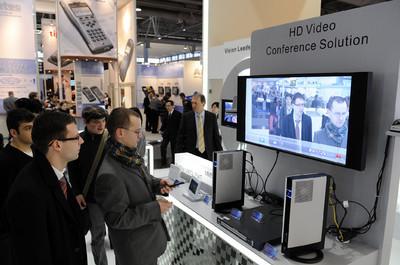Thanks to the combination of a solid-state electron emitter and a micro-hole plasma device, researchers at the University of Illinois have succeeded in developing a plasma transistor that could be used in the future to create lighter, cheaper and sharper flat-panel displays than ever before.

Thanks to the combination of a solid-state electron emitter and a micro-hole plasma device, researchers at the University of Illinois have succeeded in developing a plasma transistor that could be used in the future to create lighter, cheaper and sharper flat-panel displays than ever before.
"The new device is able to control both the plasma conduction current and the light emission using an emitter of five volts or less," said Gary Eden, professor of electronics and computer engineering.
The core of the new transistor is a micro-hole plasma - an electron-photonic device in which an electronically charged gas (plasma) is confined within a microscopic hole. The energy is provided by two electrodes with an electric voltage of up to 200 volts.
The research team was able to prepare the new transistor from an array of copper-coated layers in which micronozzles with a diameter of 500 microns were prepared using common photolithography methods. The electron emitter was prepared from a silicon chip coated with a thin layer of silicon oxide.
The diameter of the micro-hole is about the size of a human hair and it is filled with a small amount of gas. When the gas atoms are energetically stimulated by electrons, they begin to emit radiation. The color of the radiation depends on the type of gas present in the microhole. Neon, for example - emits red light, while argon emits blue light.
Around the plasma there is a thin covering layer known as mantle. An electric current moves through the shell not by negatively charged electrons but by positively charged ions. Since they are heavier than electrons and less easy to accelerate, the ions require a large electric field obtained by a wide voltage drop along the length and width of the shell.
This powerful electric field inside the shell also promotes the mobility of the electrons, explains the lead researcher. "By transferring electrons from the emitter to the sheath, we are able to significantly increase the current of electrons passing through the plasma, a fact that leads to an increase in electrical conductivity and the intensity of radiation emission."
Although the micro-nozzle plasma still requires a voltage of 200 volts to emit radiation and conduct current, these characteristics can be controlled by an electron emitter operating at a voltage of five volts or less, explains the researcher. The current transferred through the sheath to the plasma determines the amount of current moving between the two electrodes.
In their previous work, the research team made flat panel plasma lights from two sheets of aluminum foil separated by a thin dielectric layer of clean aluminum oxide. With this method, the researchers were able to squeeze about two hundred and fifty thousand light bulbs into a single monitor. And since displays of this type operate at atmospheric pressure, there is no need for a coating of glass to seal them. The thickness of these flat monitors is less than one millimeter.
"Our ability to control each of the micronozzles separately could make our plasma panels less expensive and have higher resolution. The new transistor can also be used for those applications where you want to use low voltage to control high amounts of energy."
The researchers described their new transistor in an article published in the scientific journal Applied Physics Letters and filed a patent application for it.

6 תגובות
What about the sed? Another fallen technology?!
A diameter of 500 microns is half a millimeter and not the thickness of a hair. Somewhere a mistake was made.
What about OLED? No interesting developments?
How I like my "soon to be good" articles
What is the resolution that can be reached with the help of this technology?
Sounds like a win win situation, it's just a shame that it is not explained why it should be cheaper and by what percentage.